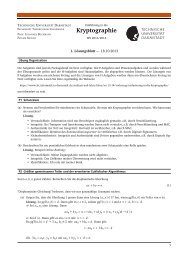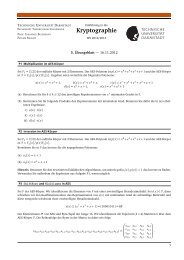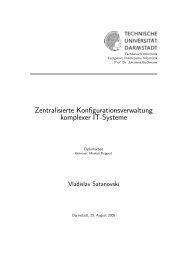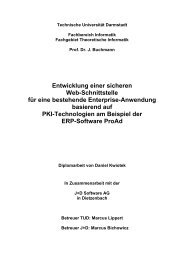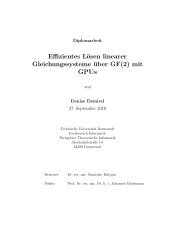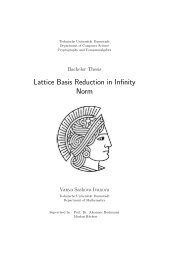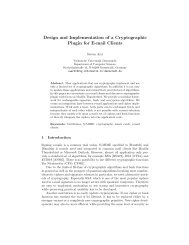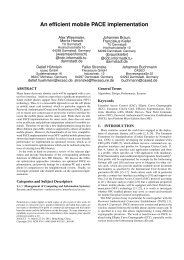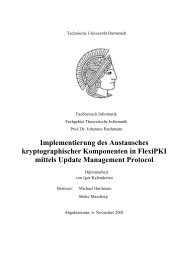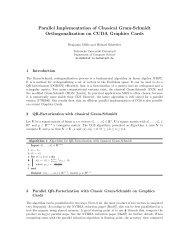Merkle Tree Traversal Techniques - CDC
Merkle Tree Traversal Techniques - CDC
Merkle Tree Traversal Techniques - CDC
Create successful ePaper yourself
Turn your PDF publications into a flip-book with our unique Google optimized e-Paper software.
Nowadays a very important role in cryptography plays the quantum computer. Integer<br />
factorization is believed to be computationally infeasible with an ordinary computer for<br />
large numbers that are the product of two prime numbers of roughly equal size (e.g.,<br />
products of two 300 - digit primes). By comparison, a quantum computer could solve this<br />
problem relatively easily. If a number has n bits (is n digits long in its binary<br />
representation), then a quantum computer with just over 2n qubits can use some<br />
particular algorithms to find its factors. It can also solve a related problem called the<br />
discrete logarithm problem. This ability would allow a quantum computer to "break"<br />
many of the cryptographic systems in use today, in the sense that there would be a<br />
relatively fast (polynomial time in n) algorithm for solving the problem. In particular,<br />
most of the popular public key ciphers could be much more quickly broken, including<br />
forms of RSA, El - Gamal and Diffie - Hellman. These are used to protect secure Web<br />
pages, encrypted email, and many other types of data. Breaking these would have<br />
significant ramifications for electronic privacy and security. The only way to increase the<br />
security of an algorithm like RSA would be to increase the key size and hope that an<br />
adversary does not have the resources to build and use a powerful enough quantum<br />
computer. It seems plausible that it will always be possible to build classical computers<br />
that have more bits than the number of qubits in the largest quantum computer. If that's<br />
true, then algorithms like RSA could be made secure by ensuring that key lengths exceed<br />
the storage capacities of quantum computers. There are some digital signature schemes<br />
that are believed to be secure against quantum computers. Thus the Lamport - Diffie one<br />
- time digital signature scheme is presented. Roughly speaking, this is a signature<br />
scheme, which is guaranteed to be secure as long as each private key is not used more<br />
than once. It is based on a general hash function.<br />
In 1979 Ralph C. <strong>Merkle</strong> presents in [MER79] a multi - time signature scheme, which<br />
employs a version of the Lamport - Diffie one - time signature scheme. In fact the <strong>Merkle</strong><br />
signature scheme transforms any one - time signature scheme into a multi - time one.<br />
This extension is made by complete binary trees, which we call <strong>Merkle</strong> trees. <strong>Merkle</strong><br />
trees stand as the very basis of this thesis and have found many uses in theoretical<br />
cryptographic constructions. The main role they play is to verify the leaf values with<br />
respect to the publicly known root value and the authentication data of that particular<br />
leaf. This data consists of one node value at each height, where these nodes are the<br />
siblings of the nodes on the path connecting the leaf to the root.<br />
In chapter 3 and 4 we will consider the main problems in this thesis - the <strong>Merkle</strong> tree<br />
traversal problem, algorithms for solving it and their comparison. The <strong>Merkle</strong> tree<br />
traversal is the task of finding efficient algorithms to output the authentication data for<br />
successive leaves. Thus, this purpose is different from other, better - known, tree traversal<br />
problems found in the literature. As elegant as <strong>Merkle</strong> trees are, they are used less than<br />
one might expect. One reason is that known traversal techniques require large amount of<br />
computation, storage or both. This means that only the smallest trees can be practically<br />
used. However, with more efficient traversal techniques, <strong>Merkle</strong> trees may once again<br />
become more compelling, especially given the advantage that cryptographic<br />
constructions based on <strong>Merkle</strong> trees do not require any number theoretic assumptions.<br />
7





